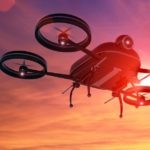Inside a drone
It's not only pilots who are caught up in the drone fever but programmers too - in just 12 hours they can make a quadcopter fly.

“They're cheap, and although it's not something you can program in a weekend, we're not talking rocket science." José María Cañas, a professor at the Telecommunications Engineering School of the Universidad Rey Juan Carlos (URJC), is the director of the Drone Programming University Course. His classroom is full of engineers but a few technical college students as well. You don't need to be an expert in aeronautics to attend the course, though some programming knowledge is required.
It's not only pilots who are caught up in the drone fever but programmers too - in just 12 hours they can make a quadcopter fly. “We don't design them and we don't teach people how to pilot them. We develop the software for the robots." According to director of the Robotics Department of the URJC, the low cost - less than 500 euros - is what has made drones so popular.
What they can do
Then there's the potential they offer: “We develop applications to control the robot autonomously. For example, research prototypes where we can program the robot to recognize people on the ground and take photos, something which is extremely valuable for search and rescue operations. We're also working on making semi-autonomous robots that can pick up images of the cracks in a building and, thanks to the software, analyze them."
Students develop applications to direct and control the drone's movements. They use the Python language and the Gazebo simulator to program the quadcopter's intelligence. To start them off, they're given various software components that have already been developed to direct the quadcopter and insert the code that controls their behavior. The students develop applications that enable the drones to "pursue" objects.
“The quadcopter's behavior is part perception, part control. The perception part picks up the sensory data - from the camera - and analyzes them to extract information. The control part decides which movement to make and issues instructions to the robot's engines," explains Cañas. The reward for the best students is testing the real quadcopter, the Parrot AR Drone.
Cañas, who is currently preparing a more advanced programming course on aircraft manned by remote control for 2015-2016, stresses that these aircraft can be used in many fields but that “there's still a long way to go and a lot to explore”.
“In Germany, the national railway operator is using drones to fight graffiti. A judge has accepted images captured by drones to fine the vandals. Drones are being used as a deterrent, and that's just one example of the multiple applications that are emerging in this field," says the URJC professor to illustrate his point.
A stroll through the curiosities of the drone world
- 'Divine Eagle', the world's biggest drone: The American magazine Popular Science features photographs of the giant Chinese aircraft manned by remote control. It stands 6 meters high, is 15 meters long and weighs nearly 15 tons. The magazine describes it as the biggest in the world, surpassing America's RQ-4 Global Hawk. The military drone can detect cruise missiles and stealth bombers in the air as well as enemy ships in the open waters of the Pacific.
- Parrot ‘Mini’ Hydrofoil, the nautical drone: It slides across the water, or more precisely 5/6 cm above it, and is controlled by a smartphone or tablet thanks to a specific application via Bluetooth. Its maximum speed is 5.4 knots and it can only be used on freshwater.
- More than 5,000 photographs: Two thousand photos were submitted in 2014 and this year more than 5,000, proving just how popular the robots have become. The Dronestagram festival organized in association with National Geographic showcases spectacular photographs of cities, nature and even dronies-selfies taken by the aircraft.
- The world's monuments: Another amazing project is the one that Amos Chapple has been working on since 2005 and which consists in taking aerial photographs of the world's most impressive monuments . Although many countries ban these types of photos in cities, you can see the images captured on the Amos Chapple website.